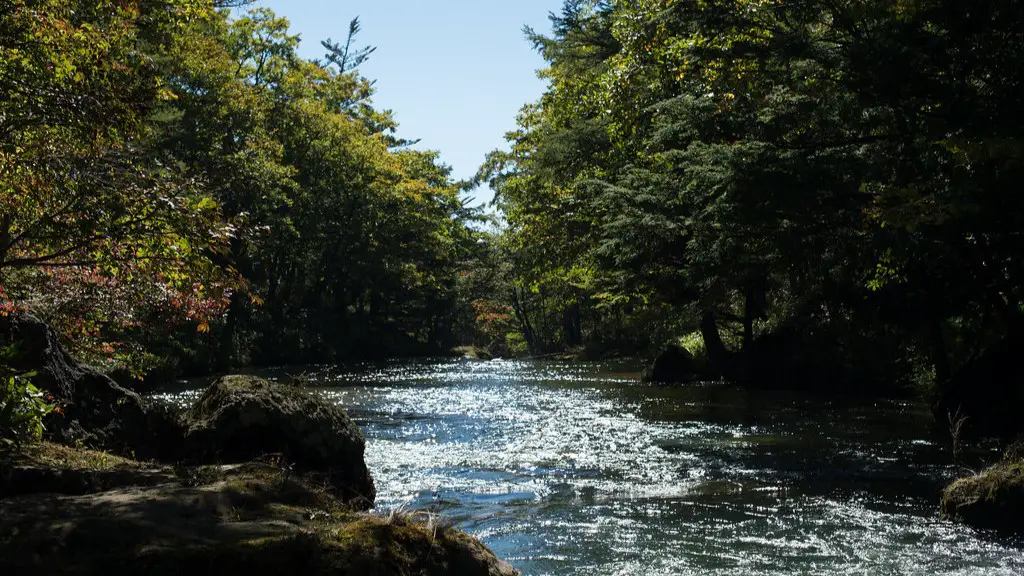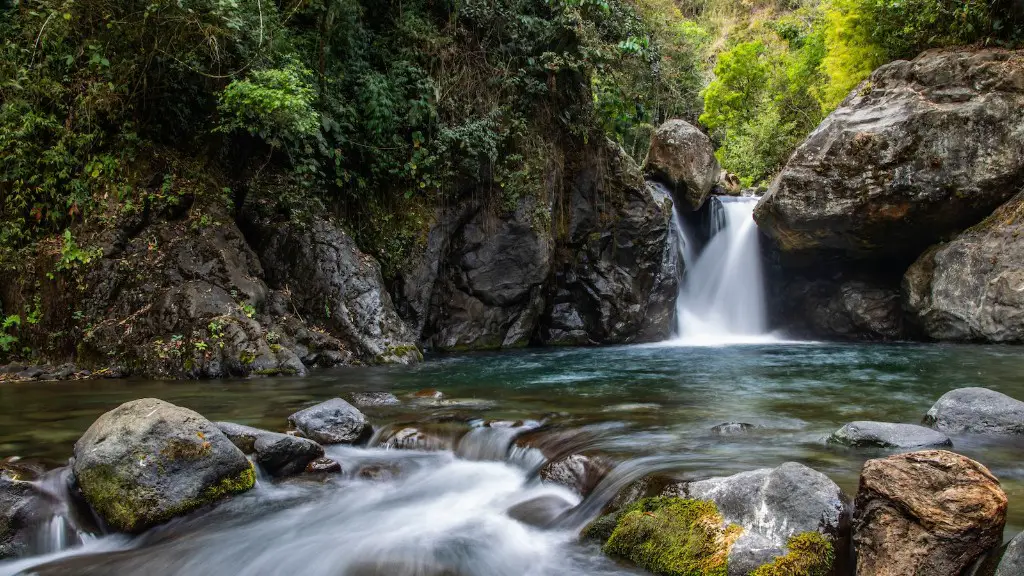The Nile River is a lifeline for countless civilizations, but does it remain clean and fit for use? This article explores the current state of the Nile River and how we can work to ensure its cleanliness for the people and animals who are dependent upon it.
The Nile River is the longest river in the world, but it is also one of the most polluted. In particular, a growing population and an increase in agricultural activities have caused serious water pollution in the region, with a significant rise in organic pollutants such as nitrogen, phosphorus and organic compounds. This is a major health concern and has serious implications for the local ecosystem.
The effects of human activities have been compounded by the drying of ancient river beds, illegal dumping of hazardous materials, over-fishing, construction of massive irrigation systems, and construction of dams. The overall health of the Nile River is also affected by climate change, which is predicted to worsen the water quality and further exacerbate the situation.
According to a report produced by the World Health Organization and UNEP, the waters of the Nile are “increasingly degraded and polluted with substantial impacts on human and environmental health”. This report highlighted the need for more stringent standards and greater awareness amongst the population when it comes to conserving and protecting the Nile River.
To protect the Nile River, there must be greater commitment from all stakeholders, including governments and local communities. One particular initiative that has been successful in this regard is the Nile Basin Initiative (NBI), which promotes collaborative and integrated management of the Nile River and its watershed. Through this initiative, governments and local stakeholders have worked together to create integrated management plans and regulations to control pollution. Additionally, technological and policy interventions are being undertaken to reduce emissions, treat wastewater, and improve the efficiency of water resources.
In addition to implementing effective policies, public awareness is key to preserving the Nile. Raising awareness about the importance of keeping the river clean is essential for reducing pollution and preserving the natural resources of the region. Government initiatives such as television campaigns, public information campaigns, and educational materials have all been used to spread understanding and awareness of the importance of preserving the Nile.
The quality of the Nile River is not only an environmental concern, but also an economic one. Pollution of the Nile threatens the health of the people who depend on it for food and water, and threatens the economic sustainability of the region. It is therefore important to ensure strict regulations are combined with public awareness and collective action to protect the Nile River and its surrounding ecosystem.
Economic Implications
The Nile River provides numerous economic benefits, including water for agriculture, livestock, and fisheries, as well as tourism and recreation opportunities. However, pollution and degradation of the river affects the economic prospects of the region and its ability to provide resources for sustainable livelihoods.
A polluted river means that less water is available for crop irrigation, which reduces crop yields and decreases income for agricultural workers. A decrease in water quality also reduces the number of fish caught and the potential for tourism along the river. This adversely affects those who rely on the river for their livelihoods, and has wider economic impacts on the communities and countries that depend on the river.
To mitigate the economic impacts of river pollution, governments and stakeholders must invest in legal framework and effective regulations to protect the river and enforce compliance with water quality regulations. Alongside this, governments must support farmers, fishers and other river-dependent communities to manage the impacts of a polluted river. This can be done through measures such as agricultural diversification and water management systems.
Environmental Impact
The quality of the Nile has significant environmental repercussions. Pollution of the Nile leads to increased algal blooms and eutrophication, reduced biodiversity, and oxygen depletion. All of this has a negative impact on the health of the river, its surrounding ecosystem, and the health and livelihoods of the human populations who live along the river.
In particular, increased algal blooms are harmful to the local environment. As algae thrive in polluted water, they take up much of the oxygen in the water, resulting in an oxygen-depleted environment which is inhospitable to aquatic life. This is a serious threat to the biodiversity of the river, particularly fish and other aquatic animals.
The effects of other types of pollution and contamination are also serious. Chemicals and other contaminants such as heavy metals, fertilizers, and industrial solvents can build up in the river, and pose a health risk to people and animals, as well as having an adverse impact on the environment.
The effects of pollution and degradation are reversible, but only if we take action soon. Governments, non-governmental organizations, and local stakeholders must commit to efforts to reduce pollution and protect the Nile from further degradation.
Solutions
To ensure the cleanliness of the Nile and its surrounding ecosystem, governments and stakeholders must implement a variety of solutions. These solutions should include initiatives to reduce pollutant emissions and prevent contamination, as well as ensure water resources are managed responsibly.
Governments must take action to reduce pollution from industrial plants and other sources. Policies such as regulating emissions and introducing wastewater treatment systems should be implemented to reduce contaminants in the river. Additionally, bans on plastic and other non-biodegradable rubbish should be rigidly enforced in order to reduce the amount of trash entering the river and its tributaries.
At the same time, sustainable water management practices must be encouraged. Measures such as water harvesting, rainwater storage, and efficient irrigation systems should be promoted and incentivized. Governments must also take action to raise awareness of sustainable water management, such as through education initiatives and public information campaigns.
Finally, riverside communities and fishermen should be empowered to take action to reduce pollution, and maintain the natural systems of the Nile River. Governments must provide support and incentives for initiatives such as the restoration of wetlands, reforestation, and the adoption of sustainable fishing practices.
Conclusion
The situation of the Nile River is dire, with serious environmental and economic impacts. However, with proper management and collective efforts from all stakeholders, the quality of the river can be improved, ensuring the health and prosperity of the region for generations to come.
Protection of the Ecosystem
It is essential to protect the natural ecosystem of the Nile River if the water quality is to be improved and the local environment preserved. Nature-based solutions such as reforestation, wetland restoration, and habitat conservation should be implemented to maintain biodiversity, reduce sedimentation, and protect the environment.
To conserve the natural ecosystems of the Nile, governments must take action to protect wildlife and habitats in the region. National parks and protected areas should be established to provide havens for wild animals and plants, and provide protection from other human activities. Governments should also support local fishermen and other resource users who rely on the Nile for their livelihoods by providing them with support, guidance, and incentives for conserving the river.
In addition to government action, civil society and non-governmental organizations must also play their part in protecting the ecosystem. Raising awareness of the importance of conservation, organizing campaigns and initiatives to conserve the river, and engaging local communities in eco-friendly activities are all essential for ensuring the health of the ecosystem.
Community Engagement
Engaging local communities and empowering them to take action is crucial for protecting the Nile. Local stakeholders and communities should be involved and consulted in all aspects of river management and policy-making, and their voices should be heard when decisions are made.
Efforts should also be made to empower local people to take action to reduce pollution. Community-led initiatives such as the development of waste management systems, water-saving initiatives, and pollution-reduction campaigns should be encouraged and supported. In addition, creating economic opportunities for people in the region is essential for motivating them to protect their environment.
Involving communities in managing the Nile River also helps build understanding and trust. In this way, communities can come together and work towards a common goal of protecting the Nile, ensuring the health and sustainability of the region.
Innovative Solutions
Innovative technologies and solutions are essential for protecting the environment of the Nile, improving water quality, and reducing the impacts of pollution. Examples of technologies that can be used include water treatment facilities and sensor systems that can detect pollution levels. Alongside this, the advancement of green energy solutions, such as solar and wind energy, are crucial for reducing the environmental impacts of energy generation.
In addition, artificial intelligence and other advanced technologies have the potential to improve water management and facilitate the detection and monitoring of pollution. By leveraging these technologies and solutions, governments, non-governmental organizations, and local stakeholders can work together to ensure the health and cleanliness of the Nile River.
Protecting the Nile River is an enormous challenge and an urgent one. However, with collaborative efforts from all stakeholders and the implementation of effective policies and innovative solutions, we can ensure the sustainability and cleanliness of the Nile for generations to come.





